Vince Darcangelo's Blog, page 16
October 28, 2012
Unsettling Chapters: King Apocalypse
In “The Hollow Men,” T.S. Eliot famously wrote, “This is how the world ends/ Not with a bang but a whimper.”
It’s obvious that Eliot never read any Stephen King!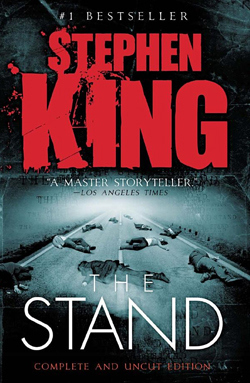
King has destroyed the world many times over, and by many different means (plague, cars, cell phones, even exploding meth labs), and each time it is most certainly with a bang. My personal favorites are The Stand and The Mist, but there’s something for everyone on his buffet of world-ending visions.
Any longtime reader of King’s knows that his strength is character development. His end-of-days narratives are so strong not because of the impending doom but for how his characters respond to it.
For example, The Stand is horrific when Captain Trips decimates the globe, but heroic when its survivors stand up to Randall Flagg. The Mist enthralls with the interpersonal conflicts that emerge within the grocery store. I’m not afraid fog-shrouded aliens, but I’m terrified of religious extremism in closed quarters.
Another favorite trick of King’s is what I call the extrapolated h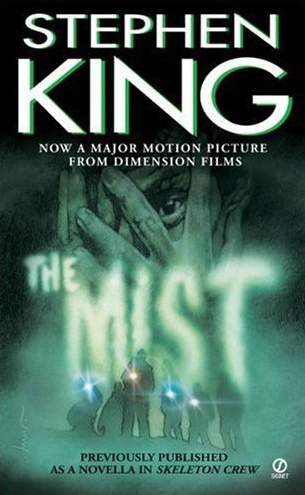 orror. “Trucks,” the short story that inspired the film Maximum Overdrive, focuses first on the ordeal of the survivors holed up in the diner. In many ways, the story is quite silly (a semi-trailer apocalypse!), but where it haunts the reader is its ending: The moment when you realize that all the horror that has come before is merely the opening act for something far, far worse.
orror. “Trucks,” the short story that inspired the film Maximum Overdrive, focuses first on the ordeal of the survivors holed up in the diner. In many ways, the story is quite silly (a semi-trailer apocalypse!), but where it haunts the reader is its ending: The moment when you realize that all the horror that has come before is merely the opening act for something far, far worse.
This is a small sampling of King’s apocalyptic works:
The Stand
The Mist
Under the Dome (sort of)
“Night Surf” (prelude to The Stand)
King has also penned his fair share of dystopian literature:
“The Long Walk”
“The Running Man”
“The Children of the Corn”
With more than 100 novels, stories and screenplays to his name, King’s bookshelf is long. Pull one or two down from the shelves this Halloween. Believe me, the end of days never sounded so good.


October 27, 2012
Unsettling Chapters: Notes from Underground
“I am a sick man… I am an angry man. I am an unattractive man.” Is there a better opening line in literature?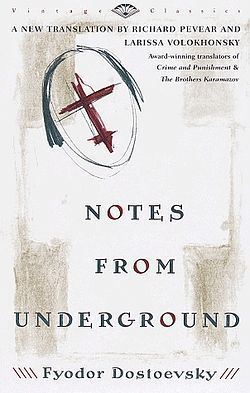
Most importantly, this sentence establishes the tone that defines Fyodor Dostoyevsky’s Notes from Underground. Considered to be the first modern novel, there is no other work that as deftly captures the anxiety of despair and inadequacy.
Our narrator, the Underground Man, guides us through a dark and unpleasant world, recounting his drab civil servant’s life and the many insults that have shaped his misanthropy. Through this, he unearths the philosophy of the underground. It is a grim, but honest view, and with no connection to the surface world, the Underground Man simmers in his despair.
Actually, I’m not sure “simmer” is a strong enough word. The Underground Man doesn’t experience pain so much as he consumes it. He recalls past injustices when there is no fresh ones to sustain him. Misery exudes from his pores, his breath, his clothes, and rather than opening a window, he basks in the stench of his humiliation.
But his ordeal has only begun.
We come to section two, “Apropos of the Wet Snow,” in which the true horror is set in motion. Here, we get more action and less confession. Following a series of insults, the Underground Man encounters a young prostitute, Liza, and for a time, redemption—and through redemption, meaning—seems possible.
Inevitably, though, you remember that you’re reading Dostoyevsky, and things become even darker than they were before. Watching the Underground Man abase himself is one thing. Watching him do it to another is harder to bear.
But of course, this is necessary to Dostoyevsky’s theme. Denigration is a team sport, and it relies on the consent of both victim and aggressor. That’s why, sadly, in the cycle of abuse, victims become abusers. We need Liza in the story to serve as witness to the Underground Man’s suffering. We need her to offer him redemption, or else he remains only a victim (which would be neither believable nor compelling). Ultimately, he is a conspirator in the surface world that has forced him underground.
And with true Dostoyevsky flair, Liza reminds us that there is no bottom. We meet the Underground Man, and we believe him to be the nadir of humanity. And then he meets Liza. We can only imagine what other characters are waiting offstage, unseen, but their suffering no less palpable.
So, this book may not be everyone’s mug of Russian Caravan, but it should still make your to-read list (especially if you’re a fan of unsettling literature). Notes from Underground is a link to the past, as it shows us that modern anxieties aren’t so new. It’s a classic work of existential philosophy. And artists and analysts alike should read this as a guidebook to the darkest shadows of the subconscious.
Notes from Underground is available as a free ebook through Project Gutenbeg.


October 26, 2012
Unsettling Chapters: House of Leaves
We are all familiar with the parameters of dream logic—the mental space where things are out of place or time but follow an alternative, interior logic. You know, like you’re catering a dinner for all your ex-girlfriends in a gothic castle, and for some reason Dog the Bounty Hunter is pitching you a show about vigilante sea lions. You wake up and wonder: “Why did that make sense?”
It’s a fun diversion that is, unfortunately, difficult to replicate in waking consciousness. But you can come close by reading Mark Z. Danielewski’s House of Leaves, a 2000 horror novel that is more of an entity than a book.
horror novel that is more of an entity than a book.
Designed with multiple fonts and colors, footnotes within footnotes and text running backward, forward, upside down, even spiraling, the physical layout of the text manipulates the novel’s pacing and creates a somewhat interactive experience.
It’s probably as close as we’ve come to reading with 3-D glasses.
The narrative is equally layered and complex, and academics have taken multiple stabs at this book. I would guess it’s had the most scholarly treatments of any horror novel since Frankenstein. Therefore, I won’t even attempt to offer an academic account, as I don’t have anything particularly profound to say on that front (and would bore myself to tears in the process).
What I can speak to is the effect Danielewski creates by inviting the reader into a story that they can’t quite trust. We have multiple unreliable narrators; the ever-shifting dimensions of a house; drug-impaired testimony; unverifiable videotapes; and the ravings of a half-mad blind man. (He also borrows the Lovecraftian theme of geometry-induced madness, not to mention a mysterious tome.)
Can we trust what we see and read? Hell no. And that’s why House of Leaves is so unnerving.
I think of it as a literary haunted house. Every October, people line up outside strip malls, warehouses and amusement parks to navigate dark, disorienting hallways. They know they won’t be harmed, but will experience the thrill of uncertainty.
The same with House of Leaves. It elicits a visceral reaction in a way few other books can. We’re aware of what Danielewski is doing. When we need to rotate the book to read the text, we know it’s to recreate the impossible geometry of the staircase. When there is one word of text on a page, it’s to replicate the cavernous quality of the basement and to force us to read slower.
But we’re affected just the same, as when we’re knowingly manipulated inside a haunted house.
House of Leaves is not a quick read. It is an experience. If you started reading it today, I don’t know that you could finish it by Halloween. But I feel confident in saying that you’re not supposed to read it that quick. This is a book to be absorbed. It should age along with you.
Read correctly, you will internalize the disorientation. You will want to measure the length of every hallway in your house to find inconsistencies. To make sure, every day, that the dimensions of your world haven’t changed while you were sleeping.
Because in Danielewski’s world, they do change. Sometimes they’ll shift right under your feet, and they might even swallow you whole.


October 25, 2012
Unsettling Chapters: All the Names
As I’ve expressed in previous posts, loss of one’s identity is one of the more unsettling outcomes a story can provide. With life such a fleeting thing, rarely does one’s name live far beyond their years.
Fair enough. To be lost to the ages is understandable, but for some, the worst fate is to be forgotten in your own time. It’s a unique flavor of despair, born of an imbalance between social needs and social disconnect.
Nowhere is this curious space more poignantly explored than in José Saramago’s All the Names.
This book was published a year before Saramago, best known for the novel Blindness, won the Nobel Prize for Literature. All the Names is worthy of such honors.
The protagonist, one Senhor José, works in a nameless city (a stand-in for Lisbon in Saramago’s native Portugal) as a low-level clerk. Similar to Dostoyevsky and Kafka, Saramago presents us with a character caught in the gears of a drab, oppressive machine of unknown origin and inexplicable intent. He works for the Central Registry, which tracks the births, marriages and deaths of all citizens. Every life is reduced to an index card bearing these dates. The job of the Central Registry is to create, update and file each card.
“We all know that, however long old people may last, their hour will always come. Not a day passes without the clerks’ having to take down files from the shelves of the living in order to carry them to the shelves at the rear…”
José, who actually lives at the Registry building, makes nightly sojourns within its stacks. He hopes to escape his “bureaucratic alienation” by searching for meaning among the necropolis of index cards. Then one day, he finds something else. He becomes fixated on the card of an anonymous woman, and begins a clumsy search for her throughout the city.
Of course, what he’s really doing is working through an existential crisis. Or some other anxiety. The archives in the Central Registry are so large that clerks have become lost in their labyrinth. The metaphor is apt for José’s anxious mind. One bad thought, and then another. Disaster lurks eternal.
It’s unsettling to think that, in the end, we’ll be little more than forgotten statistics. The same goes for everyone we love and care for. We will all be forgotten. Time will make sure of that. What’s worse, though, is to feel societal mechanisms imposing anonymity while we’re still alive. To become a living ghost.
What makes All the Names successful, as with all existentialist writings, is that the answers seem more like questions. So, what is life if but a few dates typed onto an index card? Is there meaning or merely statistical data? Like Albert Camus, Saramago reminds us that the answer isn’t important—or even attainable. The meaning lies in the pursuit of, well, meaning.
Saramago empowers us with his narrative. He reminds us that in the face of mortality, victory is not an outcome. Victory is the fight itself. It is Senhor José taking those first bold steps into the archives, dwarfed by mountains of faceless information, to turn an index card back into a person.
I’m reminded of a favorite line from Camus’ The Plague: “And indeed it could be said that once the faintest stirring of hope became possible, the dominion of plague was ended.”
Indeed.


October 24, 2012
Unsettling Chapters: Bradbury
One of America’s most influential writers, Ray Bradbury thrilled read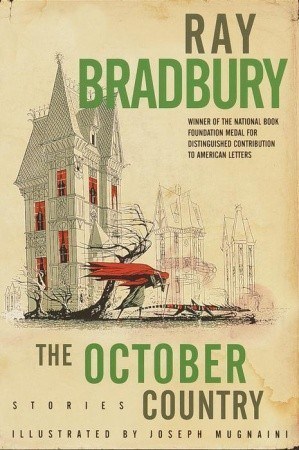 ers for decades and produced some of the defining works of the 20th century. For me, he defines a particular time in America—one of wonder and worry: the promise of space travel and the portent of a bookless dystopia.
ers for decades and produced some of the defining works of the 20th century. For me, he defines a particular time in America—one of wonder and worry: the promise of space travel and the portent of a bookless dystopia.
For more on Bradbury, below I’ve pasted the essay I wrote upon his death this past summer. “The Moonless Sleep” appeared in Transgress magazine, alongside a Bradbury tribute by the talented Stephanie Train.
But for all the great fiction he produced throughout his lifetime, I remain in awe of his 1955 debut, The October Country, a collection of short stories originally published by Arkham Press as Dark Carnival.
I don’t have much to say about this collection. The stories speak for themselves and make for a satisfying Halloween read:
The Moonless Sleep
Blaze on, ye dark carnivals, with the steam-wrought thunder of a midnight train! Gather ye lunatics, barkers and graveyard melancholics along the autumn midway! For Cooger and Dark’s Pandemonium Shadow Show has come for its maker. And sadly, under the Big Tent of terrestrial existence, the Time Carousel spins only one direction. There will be no unwinding of the years. No flip-page fountain of youth. No restoring the burnt ashes to books.
On Tuesday, June 5, Ray Bradbury—master of the grimly fantastic—died at the age of 91. He left behind hundreds of stories, novels, screenplays, teleplays and nonfiction works, spanning 1947’s Dark Carnival to last month’s essay, “Take Me Home,” in The New Yorker.
Bradbury enthralled a long-ago generation with the possibilities of space travel and the terror of a foreseen dystopia. The man’s got a Hollywood Star, an Emmy, a Pulitzer special citation and has had a moon crater and a freaking asteroid named in honor of his work.
So here’s to one of the true giants of American literature: A bittersweet slug of dandelion wine. Drink hearty, my friends.
#
Growing up a horror fan in the 1980s, I worshipped the holy trinity of Poe, Lovecraft and King. But there was always space on my bookshelf for Bradbury. It began during summer vacation—1984 or ’85—when HBO broadcast Something Wicked This Way Comes. I watched it every chance. I memorized every scene, every line. I still see the smoke of the train, feel the tickle of the tarantulas under the sheets and tighten with unease recalling Mr. Dark littering the library floor with the torn pages of Jason Robards’ life. I identified with young Will Holloway—the nervous, homebound boy who preferred travels of the imaginary and literary variety over the untamed severity of Jim Nightshade.
So began my infatuation with carnivals and the leitmotif of illusion, midway facades and the bittersweet escapism of the roadside attraction. It’s probably why I find carnivals appealing in art and depressing in real life, sort of like a dive bar during the day.
Something Wicked This Way Comes chilled me as a child, then moved me to tears as an adult when I recognized the undertone of melancholia in the narrative. I re-read it in my thirties and realized it was not so much the story of two boys, but rather the story of the father. The old man. Jason Robards in the safety of his library, puffing a pipe in a long-gone American pastoral.
Fahrenheit 451 rallied me as an angry young man, and still rumbles in my blood, much the way the dystopian works of Vonnegut continue to invade my thoughts nearly every day. We read “A Sound of Thunder” in elementary school, and I still feel the quiver in the back of my neck when we came to the end. And can anyone with an iPhone not consider “There Will Come Soft Rains” as prescient as it is brilliant?
Perhaps my favorite Bradbury work is The October Country, a stripped-down version of his story collection Dark Carnival. Even now, “The Crowd” is as haunting as ever, “Homecoming” is still creepy as hell, and I was so enamored that I once penned a prequel to “The Wind” as part of my creative writing thesis at Penn State.
Of all the dark treasures in The October Country, none affected me more than “The Scythe,” a treatise on the life cycle that feels appropriate in the wake of Bradbury’s passing. In the story, a Dust Bowl family breaks down on a dead-end street, starving and desperate. They discover a farmhouse whose owner has died, deeding the property—rich with wheat and livestock—to whomever discovers his corpse.
Of course, there is a tangled string attached.
The twist is not a huge surprise, but the story’s power comes from the author’s philosophizing on the nature of life and death. Trapped in a Twilight Zone dreamscape, protagonist Drew Erickson refuses his grim duty… and reaps an equally grim fate:
… and still they lived, caught halfway, not dead, not alive. Simply—waiting. And all over the world, thousands more just like them, victims of accidents, fires, disease, suicide, waited, slept just like Molly and her children slept. Not able to die, not able to live. (209)
#
Though best known for his fantastic vision and plotting, there is much to admire in Bradbury’s craft. The deceptive modesty of his prose, disguising his poetic bent. His command of flow and revelation. The comforting familiarity of the most unreal environs. How did he do it?
I’ve been asking that question for a few decades now, but still no luck. His book on craft, Zen and the Art of Writing, is one of the most inspiring writing primers ever penned. But like a great magician, Bradbury is just as mysterious whilst revealing his secrets.
I was fortunate to meet the author in June 1999. Bradbury spoke at the Chautauqua Auditorium in Boulder, Colo. He discussed his cinematic approach to writing. He said that people sometimes asked him how to adapt one of his stories into a film, a query at which he expressed disbelief. To paraphrase, he answered: Read it from one page to the next. “Page one, scene one.” Write as if you’re making a movie, he implored the aspiring authors in attendance.
Other tips centered on when to write that first novel (Don’t even bother until you’re thirty) and how (by threading together a series of short stories). Short fiction is rough waters for a young author—even someone of Bradbury’s talent. In the early days, he met with publishers who liked his writing, but ultimately turned him down: Call us when you’ve got a novel, they told him. Nobody wants to read short stories.
Undeterred, Bradbury got the last laugh. He repackaged and re-pitched those rejected story collections as the “novels” The Martian Chronicles and The Illustrated Man. They were published in 1950 and ’51 respectively.
He offered other anecdotes and advice, but honestly, I don’t recall much of it. I was too enthralled with his stories.
I was also shocked by his appearance. For years, he’d been using the same photo on his book jackets: a kindly, slim, frost-haired middle-ager. That was my image of him until he hobbled onto the stage, heavyset and a decade or so older than his picture. Throughout the talk, the altitude played hell with his breathing. His hair was shaggy and unkempt.
When the talk was finished, he was helped down a set of stairs to meet with fans. His legs were unsteady as he navigated the steps. An assistant held his left hand. In the right, he clutched a freshly cracked beer bottle. He held it steady and savored a long drink when he reached the small table where he would sign books. A pen in one hand. A beer in the other.
I thought: This is my kind of guy. This is my kind of writer.
I trembled as I approached the table.
#
Bradbury penned a new introduction to the 1996 edition of The October Country. It was fittingly titled, “May I Die Before My Voices.” It refers to the muses that compel him to write—the daily imaginings that inspire his stories. To some, those voices would be a burden, a form of madness. For Bradbury, it was his raison d’être.
He closes his introduction with the breathtaking lines: “If some morning in the future I wake and there is silence, I’ll know my life is over. With luck, on my last day, the voices will still be busy and I will still be happy,” (viii).
I can’t say if the voices were still speaking to him on June 5, but I feel comfortable saying that Bradbury’s voice is as resonant as ever. More than half a century after the release of Fahrenheit 451, dystopian literature still tops the best-seller and box-office charts. The universe is as mysterious as ever, and we have yet to walk on Mars or time-travel to hunt dinosaurs.
For these reasons, his timeless visions will continue to enthrall. I will certainly die before Bradbury’s voice gives out, and I’m happy to think that there will come future generations that will be equally comforted and inspired by his words. His prose that rockets off the page, that transports the reader in time, space, and can elicit moisture in the eye as effortlessly as a scream in the throat.
Bradbury’s gone, but his voice remains. To thrill us. To haunt us. To fill us with wonder. To remind us that we need not fear the voices in our own heads ever going silent. Because hopefully, surely, our voices will resonate beyond our meager, terrestrial lives.


October 23, 2012
Unsettling Chapters: Pseudopod
The apocryphal saying goes, “May you live in interesting times.” Indeed, the publishing world is in something of a fugue state these days (or should we say the past decade).
But rather than a curse, I consider it a good thing. I’ve found that  I prefer reading magazines and newspaper articles on my Nook.
I prefer reading magazines and newspaper articles on my Nook.
Programs and Web sites like Calibre, Byliner and Instapaper have made long-form journalism accessible to wider audiences, and audio books and podcasts have opened up new literary avenues for both writers and readers.
The latter, in particular, have made it possible to “read” while driving or drifting to sleep.
And when it comes to audio horror, Pseudopod stands head and tentacles above the rest.
Launched in 2006, Pseudopod recently broadcast its 300th episode… and the body count continues to rise. Featuring weekly short stories from contemporary horror authors, occasional flash pieces and periodic classics, the podcast has something for everyone.
There are brilliant tales of ultraviolent, existential horror (“Counting From Ten,” “The Duel”); grim philosophy (“Some Things Don’t Wash Off,” “What Dead People Are Supposed to Do”); dark fantasy (“Goon Job,” “Full Moon Over 1600”); adventure, both internal and external (“The Primakov,” “The Greatest Adventure of All”); and Lovecraftian weird (“Hometown Horrible,” “Jihad Over Innsmouth”).
Those are only 10 of the 300-plus stories Pseudopod has produced, and the chills keep coming. Former editors Mur Lafferty and Ben Phillips seem like old friends, and host (and an initial contributor) Alasdair Stuart is in the class of Rod Sterling and Jack Palance. I’m awed, weekly, by his haunting delivery and thoughtful post-story editorials. Even when the featured story is so-so, Stuart’s commentary alone is worth the listen.
The podcast is free, and may be downloaded through a program such as iTunes. You can also access the entire archive of stories at the Web site.
Despite being free, Pseudopod is a professional, paying market, and it runs on donations from listeners. My suggestion, especially if you’re new to the program, is to order the archive discs (which also make great gifts). Sure, I’ve got my favorite episodes on my computer, but by purchasing the discs, I have a permanent hard copy and have supported a great cause at the same time.
Other must-listen stories include “Raising Eddie,” “Bag Man” and “The Hand You’re Dealt.” But with a few hundred stories to choose from, this podcast has something for everyone’s Halloween hit list.


October 22, 2012
Unsettling Chapters: Madness
For me, the most unsettling type of literature deals with mental illness or cognitive degeneration. Internal threats are always more terrifying than those coming from  outside. Self-inflicted wounds cut the deepest, and loss of cognitive faculties is perhaps worse than death.
outside. Self-inflicted wounds cut the deepest, and loss of cognitive faculties is perhaps worse than death.
That’s why many of the books we’ve discussed, thus far, have concerned mental illness. And it’s a topic that has fascinated many great writers. Today, I’ll look at works from three legendary authors—Leo Tolstoy, Nikolai Gogol and Lu Xun—that are each unsettling in their own way.
First, Tolstoy’s “The Notes of a Madman,” his short story based on a real-life panic attack he experienced in 1869.
What I find interesting about Tolstoy’s story is that mental illness is not a major theme, and he’s not making a grand statement about either insanity or the health care industry. Rather, his story is describing what we today know as depression and dissociation. It’s interesting to read a work that presages what we consider to be a modern malaise.
It’s also interesting to consider how the story would read if written today, with therapeutic language in common usage. As this story predates the official advent of psychotherapy, Tolstoy uses more everyday expressions to describe his panic attack: “At last we came up to a small house with a post beside it. The house was white, but appeared terribly melancholy to me, so much so that I was even filled with dread.”
This feeling of dread results in a dissociative moment, and ends with a suffocating awareness of death—not the narrator’s impending death, but the fact of life’s cessation. “A cold shudder ran down my back… I saw and felt the approach of death, and at the same time I felt that it ought not to exist.”
He traces this feeling back to his childhood, in which a similar fear overtook him when he was told stories of Jesus and his suffering. We now know that early childhood traumas establish patterns and plant seeds of self that often bloom as we approach middle age (the narrator is 35).
It’s easy to think of our modern anxieties as unique to our time or our culture, and yet this story reads like a contemporary work (horse-drawn carriage and candle lighting aside). In this way, and not necessarily by intention, Tolstoy reveals the universality of anxiety, depression and dissociative episodes.
Tolstoy’s brilliance is his ability to deliver his account as a first-person narrative. True, impaired characters tend to be unreliable narrators, but what is gained with this POV is the personal detail of the panic attack, which is vivid and horrifying. Tolstoy reminds us that self-awareness is common in these types of episodes, which is perhaps the most unsettling aspect of this story—not that we experience madness, but that we are fully aware of what’s happening.
Gogol took a farcical approach in his story, “The Diary of a Madman.” This is a first-person account of a Russian civil servant, Poprishchin, who winds up in an asylum.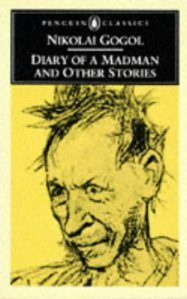
Told in diary format, Gogol is able to develop conflict, desire and even self-description—a tricky proposition with an unreliable narrator.
Poprishchin is a low-ranking clerk who feels looked-down upon by his superiors and fails to project the same superiority over his subordinates. He is a man relegated to performing menial tasks with no sense of purpose or respect, and certainly not social status.
Here, Gogol taps into a human universal: The need for self-actualization. A sense of purpose, a belief that our work, no matter how undesirable, has a bigger meaning.
In lieu of that, Poprishchin would settle for a meaningful romantic relationship. But he’s past 40, and he pines for his boss’s beautiful, young daughter, with whom he stands no chance of notice. Eventually, Poprishchin spirals out of control. He believes he is privy to a conversation between two dogs (and that they are corresponding via letters and making fun of him). He stalks his boss’s daughter, an act which seems perfectly reasonable to him. And he is so troubled by the absence of a king in Spain that he convinces himself that he is the king of Spain. He asks, “How can a throne be vacant?… A state cannot be without a king.”
Finally, there is Lu Xun’s “A Madman’s Diary.”
The misconception some people have is that mental illness is simply a break from the commonly agreed-upon narrative of reality. But people dealing with men tal distress are also living within a personal narrative that is every bit rooted in common sense and, more importantly, cause and effect as ours. What may seem disjointed to the group may seem perfectly linear to the individual.
tal distress are also living within a personal narrative that is every bit rooted in common sense and, more importantly, cause and effect as ours. What may seem disjointed to the group may seem perfectly linear to the individual.
The challenge is capturing that experience in fiction. Lu Xun employs two common devices, both of which, while effective when this story was published a century ago, would be difficult to get away with in modern literature. He starts with the voice of reason: a man introduces the diary of a friend who suffered from paranoid delusions, ostensibly for the purpose of medical research. Then we receive the voice of the narrator through a series of diary entries.
What I like about Lu Xun’s approach is that he puts us in the mind of the mentally distressed. Xun’s narrator begins with a common anxiety that others are looking at him strange, perhaps joking about him in the street and planning to harm him. Some local children laugh when they see him, and he deduces that they must have been instructed to do so from their parents.
Then, he overhears a story about a nearby village where cannibalism is still practiced. This manifests as an obsessive fear of being eaten, and soon he believes that the children, his brother and the whole of the town intend to kill him and eat his flesh. This escalates into more dire theories.
When we write about the mentally ill, there is tendency to reduce them to the “other.” Going first-person, seeing through their eyes, offers some insight, but is still limited if we meet them in what we perceive to be a static state of being (e.g. sane vs. insane). But following the narrator’s descent illuminates the insidious nature of mental illness and distress. Lu Xun does a great job of capturing that in this classic tale.
And there are certainly others we could discuss, perhaps in future installments. But for now, these are three classic takes on mental illness that have much to offer to the conversation of madness in literature.


October 21, 2012
Unsettling Chapters: In the Black Mill
Sadly, there is a great divide in the literature world, one which I don’t really understand. Having completed an MFA program, I can speak to the snootiness of the literati establishment and its delineation between literary and genre fiction.
Personally, I believe it’s all simply fiction, and if there is any division, it’s between well-written fiction and not-so-well-written fiction.
But rather than rehash this tired debate, I’d like to talk about a writer who obliterates this divide, Pulitzer Prize-winning author Michael Chabon. He has explored genre and pulp fiction in his novels The Amazing Adventures of Kavalier and Clay, The Final Solution and The Yiddish Policemen’s Union and as editor of McSweeney’s Enchanted Chamber of Astonishing Stories.
Perhaps his most daring genre work is the short story “In the Black Mill,” an homage to Lovecraft that first appeared in Playboy and later in his collection Werewolves in Their Youth.
For my money, “In the Black Mill” is the greatest Lovecraft-inspired work ever written. However, in full disclosure: I grew up in a rusting steel town outside of Pittsburgh, which is the setting for “In the Black Mill.” Lovecraftian horror set in the Rust Belt of my youth? A forbidden ritual centered on an old steel mill?
Sign me up.
I don’t want to get into specifics, or give away too much, other than to say the pleasure of reading “In the Black Mill” comes from its balance of originality and familiarity. A lot of Lovecraft-inspired fiction comes across as overly referential or derivative. Chabon infuses the old legends with a post-industrial setting, a brilliant ending and a healthy dose of meta-fiction.
But for all the new wrinkles, Chabon links up with Lovecraft via three avenues: thematic connections, stylistic connections and familiar places and names.
First, the thematic connections:
There is a narrator called away from home, in this case an archeologist (Lovecraft was fond of having scholars or heirs travel to strange locales). Upon arrival, he encounters numerous grotesqueries among the local folk: physical deformities, impurity (particularly of food and drink) and increasingly odd and suspicious behavior. All classic Lovecraft devices, particularly his penchant for displacement.
Stylistic connections:
Here, Chabon deviates from his typical style and writes with Lovecraftian grandiosity. See un-Chabon-like phrases such as “…the immemorial accursedness of his drab Pennsylvania hometown” and “…the eldritch moment.” The narrator also pays close attention to setting and description, much like HPL. We come to know the topography of this Rust Belt village as well as we know Arkham, Dunwich and Innsmouth, “that ill-rumoured and evilly shadowed seaport of death and blasphemous abnormality.”
Likewise, Chabon draws a third connection to Lovecraft by utilizing similar places and names. There is the Miskahannock river and valley (what I imagine to be an amalgamation of Lovecraft’s Miskatonic river and valley and “hannock,” a variation of the Delaware Indian word for “stream,” which is a commonly used suffix in Western Pennsylvania, as in Neshannock Township). There are the Yuggogheny Hills (Yog-Sothoth meets the Allegheny) and then characters named Philippa Howard Murrough and August Van Zorn.
Perhaps the greatest commonality between this story and HPL is philosophical. Lovecraft exceled at presenting what appeared to be insurmountable terror, only to reveal at the end that the evil is even greater than at first imagined. It’s not the personal torment that is so horrifying, but scope. The implication that the nightmare has only just begun, and eventually, we will all suffer the narrator’s fate.
This is post-industrial Rust Belt horror at its finest.


October 20, 2012
Unsettling Chapters: The Church of Dead Girls
Frequent readers have probably noticed a pattern among the entries of Unsettling Chapters. That is, the overt theme of a story is more often a sleight of hand. Put  another way: The thing is not really about the thing.
another way: The thing is not really about the thing.
Lovecraft’s Old Ones are a manifestation of his insecurities. McEwan’s transgressions are a front for the anxiety of individuality in the face of rigid and arbitrary social mores. Murakami’s gore portrays mental disturbances rather than literal scenes.
And so it goes with Stephen Dobyns’ 1997 mystery, The Church of Dead Girls.
As with Birdman, Mo Hayder’s debut discussed on Oct. 5, the ghoul in this novel uses human corpses as an artistic medium. But while The Church of Dead Girls offers terror and thrills, it also has high-minded literary aspirations.
The thing is not really about the thing.
This is less a whodunit and more a sociological work. What are the fears and biases of small-town folk? What prejudices are lurking in the shadows? A rash of murders and missing teenagers brings them all to the surface. Things get ugly.
“The Monsters Are Due on Maple Street” ugly.
Once threatened, the townsfolk begin pointing fingers in every possible direction. This compelling arc makes for a fascinating read. And gruesomely detailed horrors make this a must-read for Halloween.
Speaking of fingers, whatever happened to those missing left hands?
Read the book and you’ll understand.
Parts of this post are adapted from an earlier article of mine, “Thirteen horrifying reads for Halloween,” which appeared in the Boulder Camera in 2008.


October 19, 2012
Unsettling Chapters: H.P. Lovecraft
Now, to one of my all-time favorites, H.P. Lovecraft.
The Wizard of Weird is one of the most puzzling figures in literature (no s mall feat) and a most peculiar phenomenon. Hardly read in his lifetime, his stories have since inspired movies, music, video and board games and countless writers.
mall feat) and a most peculiar phenomenon. Hardly read in his lifetime, his stories have since inspired movies, music, video and board games and countless writers.
The reclusive author of the Cthulhu Mythos is often overshadowed by the larger-than-life Lovecraft Mythos distilled from his letters, essays and fan speculation.
From this end of the millennium, he appears as a man out of time, which perhaps accounts for the skilled depictions of isolation and despair in his work. A troubled life, an early death—these are the makings of a horror legend.
For the HPL initiate, the place to start is The Best of H.P. Lovecraft: Bloodcurdling Tales of Horror and the Macabre. This collection of 16 of his best-known stories proves his staying power. My favorite is “The Outsider,” a dark epic of self-discovery. This story speaks to me as few stories can, and I believe this is Lovecraft at his most earnest.
“Pickman’s Model” and “The Picture in the House” explore the intersection of art and madness. For HPL, this crossroad manifests in the form of weird fiction, but I can’t help but wonder at his deeper intentions in these stories.
Likewise, “The Music of Erich Zann,” one of the finest pieces of horror fiction I’ve ever read. In a forgotten section of, presumably, Paris, a young student rents a room beneath a master violist. The man performs strange melodies at all hours of the night, and when the narrator learns of their origin… well, the story takes a classic Lovecraftian turn, but with more subtlety and greater effect. From a craft perspective, this is one of his best works.
From a reader’s perspective as well.
And I’ve got to touch on “The Rats in the Walls,” as great a depiction of psychosis and inherited guilt ever written. Be warned: It’s usually easy enough to overlook some of Lovecraft’s subtle racism, but it sits front and center in this story, which makes it tougher to swallow. If you can stomach that, you’ll enjoy this thoroughly gut-churning tale.
Then, of course, there are the mega-hits: “The Call of Cthulhu,” “The Dunwich Horror,” “The Shadow Over Innsmouth.” There’s not much I can really add to the discussion of these classics, other than to chuckle (and sometimes cringe) at Lovecraft’s story titles. He had a penchant for the noun-prepositional phrase structure favored by the pulps (“The Colour Out of Space,” “The Haunter of the Dark,” “The Thing on the Doorstep”) or a variation thereof (“At the Mountains of Madness,” “Beyond the Wall of Sleep”).
The greatest thing to happen to Lovecraft fans in recent years is the H.P. Lovecraft Literary Podcast, a thoughtful and well-produced audio chronology of his work. They started in 2009, discussing one story at a time (one episode for shorter works, multiple episodes for longer ones), and came to the end of his oeuvre earlier this year. They offer all kinds of goodies for Miskatonic alumni, including professional readings, old episodes and original works.
Best of all, though Lovecraft has been gone 75 years, his mythos live on. There are numerous collections of Lovecraft-inspired fiction, such as Future Lovecraft and Shadows Over Baker Street (an HPL/Sherlock Holmes mash-up). Writers such as Michael Chabon, Stephen King and Neil Gaiman have all contributed to the ongoing mythos.
And there is a new crop of writers adding to the legacy all the time. I highly recommend checking out the Lovecraft eZine, which publishes great artwork, weird fiction and weekly Web updates and video chats.
As a wise man once said, “That is not dead which can eternal lie.”





